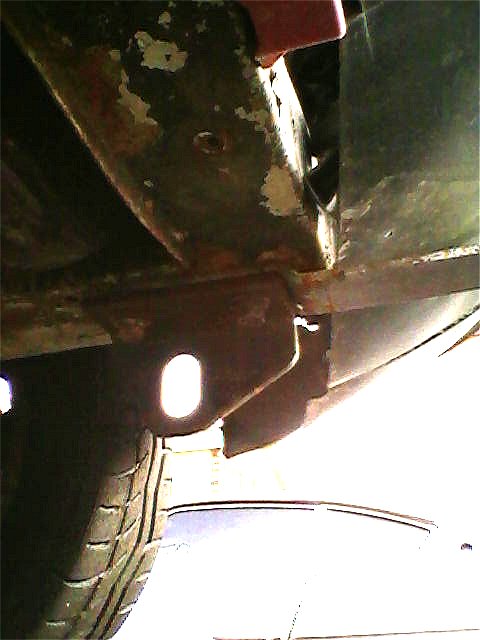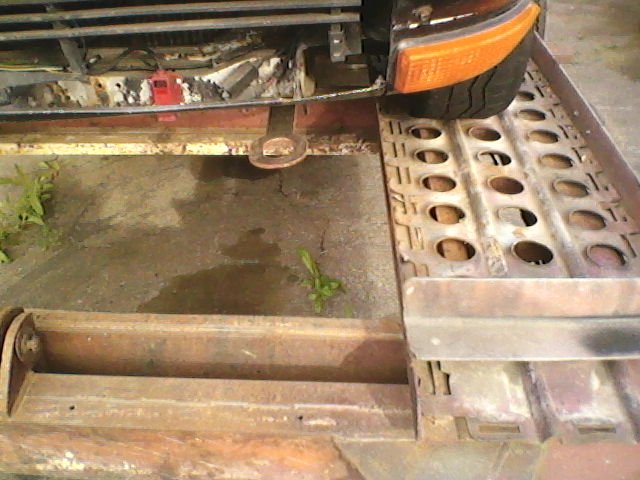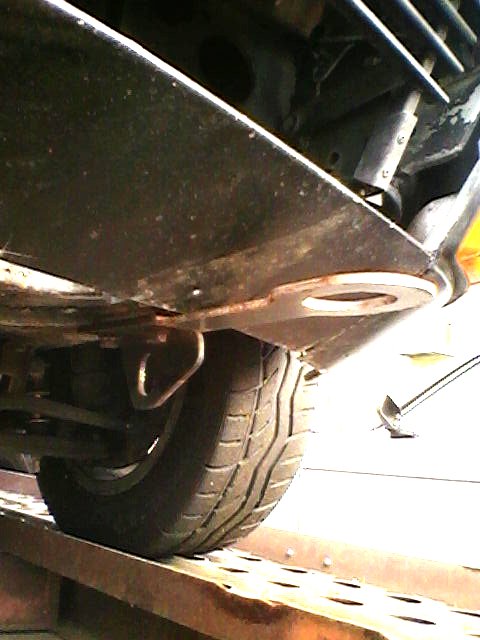Everything posted by beermanpete
-
Did I get everything?
That looks ok to me and is the same as what I did.
-
Volt gauge drops to 0, but engine cranks and starts
It sounds like you might have two (or more) problems. Assuming that it all started when you did the engine/carb swap, start by looking for cut or pinched wires, unhooked ground between the body and the engine, etc. The first issue, voltmeter reading falling when turning on the electrical accessories, is likely a poor connection somewhere. Just good enough to power the volt meter but has a large resistance and therefore a large voltage drop with any real load. The second issue, blowing the fusible link at the alternator output, could be due to a bad alternator/regulator or a missing voltage sense at the S-terminal (as Zed Head already mentioned). Try letting the car run but don't race the engine. When the engine is at idle the alternator output won't be enough to blow the link and you will have time to perform tests.
-
Volt gauge drops to 0, but engine cranks and starts
Aside from the fusible link CO mentioned, there are other common components in the circuit you are having trouble with. Check the condition of the terminals in C-9 and the point where the large white/red wire attaches to the fuse block. Look for signs of heat and corrosion. Take the connector apart and look at both parts to be sure it is clean and tight. Any sign of heat, such as a discoloration in the plastic housing or corrosion on the terminals, indicates a loose or dirty connection.
- Battery Disconnect (Cutoff) Switch)
- Battery Disconnect (Cutoff) Switch)
-
Tow Hooks
Thanks. I suppose the loop in the front could be lower. The further off center from the attachment point it gets the more likely it will bend during use. Perhaps making it a bit longer would provide the same gain in scratch prevention without increasing the tendency to bend too much. Of course, this depends on where the tow strap attaches to the tow vehicle.
-
Tow Hooks
I made a front tow hook that attached to the factory tie down point and clears the valance. The rear is not as easy and I have not attempted anything there yet.
-
Engine only runs with starter fluid
Good. The needles are fine. The next step is to swap the pots to the alternate carbs and see if the problem moves to the rear carb or stays in the front carb.
-
Engine only runs with starter fluid
Be careful using abrasives to clean the needles. If any of the original material is removed it will affect the fuel/air mixture. If the needle is bent replace it. They are not hard to get. The symptoms reported indicate a problem with the damper (pot) at the top of the carb, not the needle. Focus on one issue at a time and do what you can to isolate the various components in the system to determine which part is at fault. For example, remove the pots and see how the vacuum piston moves. If it move freely then the needle and nozzle are ok. Next, add the pot if the vacuum piston now sticks the problem is with the pot or the bore it rides in (in the vacuum piston). If there is still doubt about the culprit, remove the nozzle and/or the needle and check the piston operation again with only the pot. Divide and conquer.
-
Engine only runs with starter fluid
It sounds like the shaft for the pot is bent a bit. Try swapping the pots between carbs. Maybe it will work better. At least if the problem moves with the pot or not you will know which component is actually at fault. Have you inspected the bore the pot rides in? Perhaps there is a some debris in there or maybe it is not round or not straight. What type of measuring tools do you have to inspect such things?
-
Scary Incident: No Brakes!
Scary! There should have been some brake action on the front system. Check for a problem in the front brakes while you are in there.
-
Mismatched battery cables?
No. The battery cables do not need to be the same wire gauge. 4 gauge is ok. 1 gauge is, perhaps, unnecessarily large but will not cause any problem.
-
Do You Wear Driving Gloves?
There is a functional aspect to the gloves for sure. In my case, the Z no longer has the original thin smooth steering wheel and the Miata has a thicker padded wheel that is a bit grippy on its own so the need for additional grip is reduced. For me the style aspect is not high on my list but for street use does outweigh any functional need. I like what I consider a somewhat erstwhile look and the romance of the "old days" when "motoring" was a thrill and a more esoteric pursuit than it is today. All I need is a flat cap and a picnic basket with lunch and a bottle of wine in the boot (and maybe a long scarf flying in the wind) and the look will be complete.
-
Do You Wear Driving Gloves?
I wear gloves in the Z because it is required for the time trial activity I participate in. I would likely wear gloves even if it was not required. I have been wearing gloves while driving my Miata lately as well, partly because it has been cold (as Los Angeles goes) at times during the winter and partly because it seems stylish or cool. I have thin leather gloves that are sold as motorcycling gloves which are comfortable and thin enough to have good dexterity for driving functions such as operating the light switches and such.
-
Battery not charging with new 60A internal regulator alternator
Good job finding the diode problem. Too bad it still has a problem. Zs-ondabrain's suggestion to check the fuse box connections is on target with the symptoms reported. You have an open circuit between the alternator output and the battery. Be sure to check the large multi-pin connector in the passenger foot well where the engine room harness connects to the instrument panel harness. The white and white/red wires the charging system pass through this connector and the terminals could be dirty, corroded. overheated, etc. If I recall correctly, there are two single pin connectors in the ammeter circuit, one for the white wire and one for the white/red. Check these as well if you have not removed them as part of your ammeter bypass.
-
Battery not charging with new 60A internal regulator alternator
I did misread SurferD's post regarding the ammeter working. I have never seen a wiring diagram for the 70 Z. My comments are based on the 72-73 wiring diagrams. The basic arrangement is the same in the diagram posted above. The fusible link shown in the diagram above is not shown in the 72-73 wiring diagrams. The ammeter shunt is internal in the early models. 74 is the first year that uses an external shunt. This means all of the current into and out of the battery (except the starter motor) goes into the cabin and through the ammeter in the early models. The alternator output feeds the fuse box via a white/red wire 10 gauge. This is the most likely circuit that would cause the symptoms reported.
-
Battery not charging with new 60A internal regulator alternator
The alternator output does not go directly to the ammeter. The whole car, minus the battery, is connected to the alternator output. The ammeter is in series with the battery, minus the starter. Your comment that the ammeter does not move when turning on a load ( headlights, etc.) BUT the load operates might be telling. Is this while the engine is running or stopped? The smoke that occurred and then stopped could be due to the smoking component burning out. Considering your comments, the ammeter comes to mind. There is only one fusible link in the early cars. If you can start the engine, operate the lights, horn, etc. then the link is ok.
-
Race and Time Trial - June 4-5, 2016 - Buttonwillow Raceway
The Alfa Romeo Owners of Southern California are co-hosting (with NCRC) a race and time trial event at Buttonwillow Raceway June 4-5, 2016. http://www.aroschpd.org/events/2016/jun2016_bw.html I will be there with our '73 240Z. All cars and driver experience levels are welcome.
-
DIY tach adapter for aftermarket igntion boxes (MSD, Crane, etc.) using GM HEI module
I don't see any schematics or links to them. Anyhow, if you are assuming you can short the output of the HEI module and rely on the internal current limiting to protect it: I doubt that will be reliable. You will need a 3 ohm (or so) resistor of suitable wattage as a load. The waveform that results from the points and condesner is rather messy and has a lof of over-shoot and ringing that the tach may have been designed around. I repaired my tach a while back and could not get it to respond to a squarewave generator on the test bench. Considering the foregoing, I wonder it the 4-wire tach will respond to the reasonably clean rectangle waveform that is likely the result of your suggestion.
-
73z turn signal wiring photo?
At this point I would likely be removing the tape from the bundles to trace the specific wires from point to point. The wiring diagram does not show any connector or color change in the white wire between the flasher and the T/S switch. Clearly there must be at least one joint near the T/S switch. The wiring diagram in the link Steve provided indicates a joint and color change from white to green. Since you can plug the black wire (which should be ground) into the red wire (which should be hot when the headlights are on) and get power on the green wire at the flasher (instead of a short circuit and blown fuse) a re-wire of some sort by a previous owner or repairman, or an assembly error of yours at another location besides the steering column seems likely.
-
73z turn signal wiring photo?
Now you need to follow the white wire (it is white, right?) out from the flasher, through the wiring harness, to the combination switch. The '73 wiring diagram shows the wire being white all the way to the turn signal switch. If you have different year parts it could be different. Since you have no power at the switch there must be an open circuit between the flasher and the combination swtich. If the wires are simply hooked up wrong you will have power at the switch but on the wrong wire. Be aware that all-black is ground. In your photos you show a singe white wire (coming from the switch) conected to a single black wire. This seems suspicious. Is there a singe white wire on the instrument harness side (wire loom) that has a matching connector? I have a '73 but long ago removed the wiring and set-up the car for race track use, so I cannot take any photos or look at the wiring layout for comparison to what you have.
-
73z turn signal wiring photo?
I can't tell much from your photos. You need a factory service manual with the wiring schematic so you can trace the wires by color through the car as you troubleshoot the problem. I think you can get a free copy from xenonzcars.com. Since you have no power at the turn signal switch it seems like the problem lies elsewhere. Does the car run? Does anything that is controlled by the ignition switch work (i.e. radio, heater, wipers)? Power for the turn signals runs from the ignition switch to the fuse box, then to the hazard switch, then to the flasher, then to the turn signal switch. Start by checking for power at the 20 amp fuse for the turn signals. It should be hot when the key is in the on position. Check the fuse itself and (assuming it is goog) clean it and the clips it snaps into. Next, check for power at the two green wires on the hazard switch. One is the feed from the fuse box, the other goes to the flasher. Next check for power at the flasher (the one with a green wire and a white wire, the other flasher is for the hazards). Next, check for power on the white wire at the turn signal switch. The first place without power tells you the component upstream, or a connection in-line from it is the problem.
-
73z turn signal wiring photo?
What, exactly, is not working? You said the flashers are working: Do you mean the hazards or the turn signals? If you are looking for power for the headlights, the headlight switch controls the ground, not the positive. This means that when the headlights are off there should be two "hot" wires at the headlight switch, one for the low beam and one for the high beam. If these lines are "cold" check the headlight fuse, headlights (bulbs) and so on. There should be power at each headlight at all times.
-
Engine Block plug type?
Yes, this is the drain plug. It should open into the coolant passage, so clearly there is a lot if sediment and debris to be cleaned out.
-
a few questions
The white wire on the tach is for the ignition positive wire. This is how the tach senses the ignition signal.








